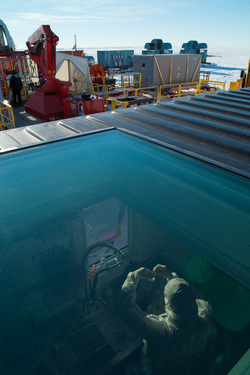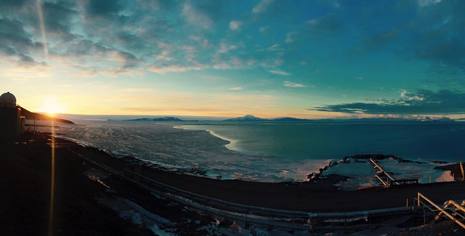Antarctic Subglacial Ecosystems
 Photo by JT Thomas.
Photo by JT Thomas.
Approximately 400 subglacial lakes are known to exist under the Antarctic Ice Sheet. These lakes lie under hundreds to thousands of meters of ice cover and contain an estimated 10,000 cubic kilometers of water. Two of these lakes have been sampled so far: Whillans Subglacial Lake (SLW) lies 800 meters beneath the surface of the West Antarctic Ice Sheet and Mercer Subglacial Lake (SLM) lies beneath 1200 meters of ice. Both drain to the ocean beneath the adjacent Ross Ice Shelf. Read about the ecology of SLW here, the physiology of SLW microorganisms here, and the biogeochemical importance of linkages between subglacial lakes and Southern Ocean here.
SLW became the first subglacial lake to be directly sampled in 2013, as part of the WISSARD project (Whillans Ice Stream Subglacial Access Research and Drilling). SLM was sampled in 2018 as part of the SALSA (Subglacial Antarctic Lakes Scientific Access) project, which Dr. Vick-Majors is a collaborator on.
In the photo, Dr. Vick-Majors is setting up experiments in the biology/chemistry lab at Subglacial Lake Whillans, with the sampling platform at the top of the image. Microbiologically clean access is a primary concern of subglacial ecosystem research, and everyone must don protective suits, like the one shown in the picture, when working with samples or going near the borehole.
In 2015, WISSARD accessed the ocean beneath the Ross Ice Shelf at the Whillans Ice Stream Grounding Zone - the point where the Antarctic Ice Sheet leaves the land and begins to float on top of the ocean. More information about ice sheets and ice shelves is available here.
SLW became the first subglacial lake to be directly sampled in 2013, as part of the WISSARD project (Whillans Ice Stream Subglacial Access Research and Drilling). SLM was sampled in 2018 as part of the SALSA (Subglacial Antarctic Lakes Scientific Access) project, which Dr. Vick-Majors is a collaborator on.
In the photo, Dr. Vick-Majors is setting up experiments in the biology/chemistry lab at Subglacial Lake Whillans, with the sampling platform at the top of the image. Microbiologically clean access is a primary concern of subglacial ecosystem research, and everyone must don protective suits, like the one shown in the picture, when working with samples or going near the borehole.
In 2015, WISSARD accessed the ocean beneath the Ross Ice Shelf at the Whillans Ice Stream Grounding Zone - the point where the Antarctic Ice Sheet leaves the land and begins to float on top of the ocean. More information about ice sheets and ice shelves is available here.
"At the bottom of this planet is an enchanted continent in the sky, pale like a sleeping princess. Sinister and beautiful, she lies in frozen slumber." - Admiral Richard Byrd

